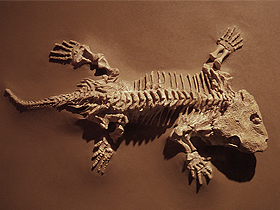Creatures such as dinosaurs, lizards, tortoises and crocodiles all belong to the reptile family. Reptiles possess unique characteristics: They are all covered in scales. They are cold-blooded and cannot produce their own body heat, for which reason they need to warm their bodies in the Sun every day. Their young hatch from eggs.
Evolution theory faces another major dilemma in explaining the origin of these creatures. Darwinists claim that reptiles evolved from amphibians, yet no concrete evidence supports this. On the contrary, a comparison of reptiles and amphibians shows enormous physiological differences between the two groups, and that any half-reptile, half-amphibian would stand no chance of survival.
One reason concerns the two groups' different egg structures. Amphibians deposit their eggs in water, and they are ideally suited to aqueous development. These eggs are highly porous, they have a transparent membrane and a jelly-like consistency. Reptiles, on the other hand, lay their eggs on land, and their eggs are ideally suited to dry conditions. The hard shell of the reptile egg, known as an amniotic egg, contains an air sac, and is impermeable to water. The water needed by the young is contained inside the egg until it hatches.
Were amphibians to deposit their eggs on land, they would soon dry out and the embryos inside would die. This is a point that the evolution theory, which maintains that reptiles gradually evolved from amphibians, cannot explain. To begin life on dry land, the amphibian's egg would have to become an amniotic one within a single generation. This could hardly occur through mutation and natural selection, the two suggested mechanisms of evolution.
On the other hand, the fossil record also removes the possibility of an evolutionary origin for reptiles. In an article, "Problems of the Origin of Reptiles," the well-known evolutionist paleontologist Lewis L. Carroll admits as much:
Unfortunately, not a single specimen of an appropriate reptilian ancestor is known prior to the appearance of true reptiles. The absence of such ancestral forms leaves many problems of the amphibian-reptilian transition unanswered. 135
Robert L. Carroll, regarded as an authority on vertebrate paleontology, accepts that "The early amniotes are sufficiently distinct from all Paleozoic amphibians that their specific ancestry has not been established."136 Carroll also makes these comments in his book:
When they first appear in the fossil record, both frogs and salamanders appear essentially modern in their skeletal anatomy. . . Despite these similarities, frogs, salamanders, and caecilians are very different from one another in skeletal structure and ways of life, both now and throughout their known fossil record . . . we have found no fossil evidence of any possible antecedents that possessed the specialized features common to all three modern orders.137
The most important creature that evolutionists have so far sought to portray as the "ancestor of reptiles" is the fossil amphibian Seymouria. Yet the discovery that reptiles were alive 30 million years before Seymouria's appearance revealed that this cannot be an intermediate species. (See Seymouria.)
It is of course impossible for "the forerunner of reptiles" to have first appeared long after them. The scientific facts show that reptiles emerged on Earth not through the gradual change maintained by the theory of evolution, but suddenly, with no antecedents.
135. Lewis L. Carroll, "Problems of the Origin of Reptiles," Biological Reviews of the Cambridge Philosophical Society, Vol. 44, p. 393.136. Robert L. Carroll, Vertebrate Paleontology and Evolution, New York: W. H. Freeman and Co., 1988, p. 198.
137. Ibid., pp. 180-182.


